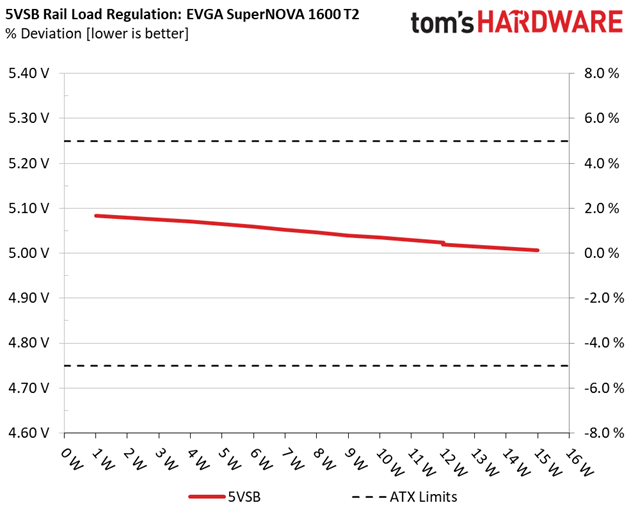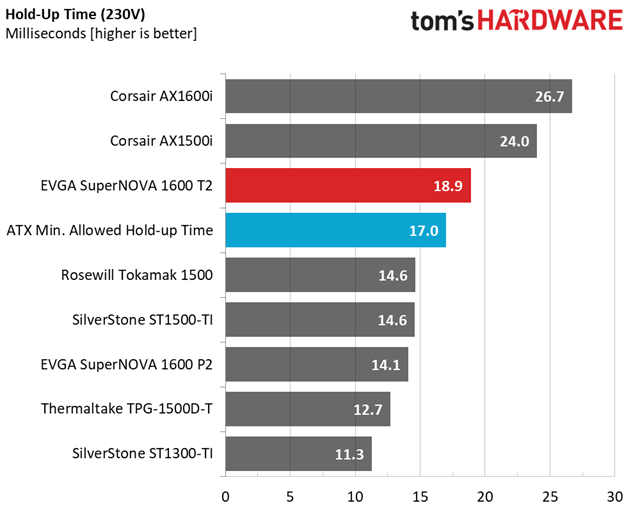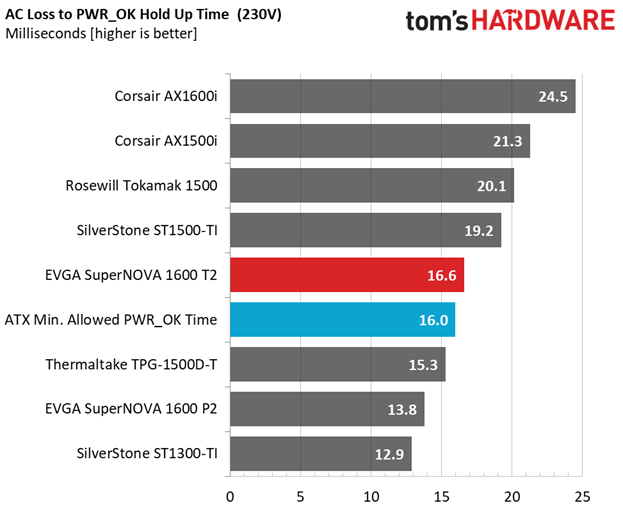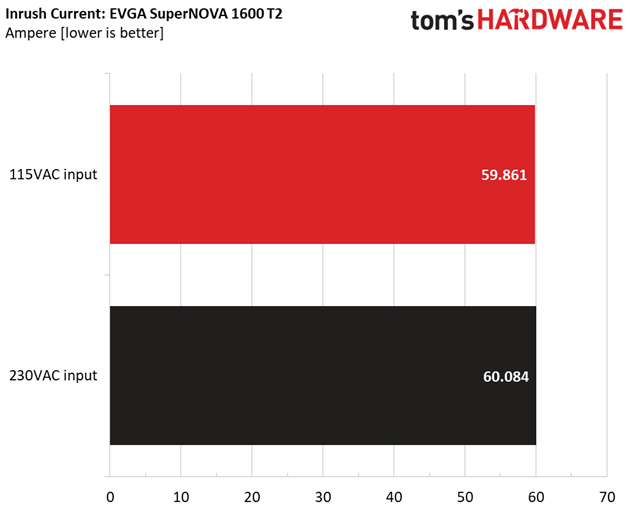EVGA SuperNOVA 1600 T2 PSU Review
Why you can trust Tom's Hardware
Load Regulation, Hold-Up Time & Inrush Current
To learn more about our PSU tests and methodology, please check out How We Test Power Supply Units.
Primary Rails And 5VSB Load Regulation
Load Regulation testing is detailed here.








Hold-Up Time
Our hold-up time tests are described in detail here.







The hold-up time we measure isn't as long as Corsair's AX1600i, but it's still satisfactory. Moreover, the power-good signal is accurate.
Inrush Current
For details on our inrush current testing, please click here.


Due to the high-capacity bulk caps, inrush current is higher than we're used to with both voltage inputs.
Load Regulation And Efficiency Measurements
The first set of tests reveals the stability of the voltage rails and the 1600 T2's efficiency. The applied load equals (approximately) 10 to 110 percent of the PSU's maximum load in increments of 10 percentage points.
Get Tom's Hardware's best news and in-depth reviews, straight to your inbox.
We conducted two additional tests. During the first, we stressed the two minor rails (5V and 3.3V) with a high load, while the load at +12V was only 0.1A. This test reveals whether a PSU is compatible with Intel's C6/C7 sleep states or not. In the second test, we determined the maximum load the +12V rail could handle with minimal load on the minor rails.
| Test # | 12V | 5V | 3.3V | 5VSB | DC/AC (Watts) | Efficiency | Fan Speed | PSU Noise | Temps (In/Out) | PF/AC Volts |
|---|---|---|---|---|---|---|---|---|---|---|
| 1 | 11.341A | 1.987A | 1.987A | 0.987A | 160.130 | 90.895% | 0 RPM | <6.0 dB(A) | 41.81°C | 0.976 |
| 12.215V | 5.033V | 3.321V | 5.065V | 176.170 | 38.19°C | 115.75V | ||||
| 2 | 23.658A | 2.982A | 2.982A | 1.186A | 319.806 | 93.366% | 0 RPM | <6.0 dB(A) | 42.89°C | 0.992 |
| 12.212V | 5.030V | 3.318V | 5.059V | 342.528 | 38.56°C | 115.64V | ||||
| 3 | 36.309A | 3.479A | 3.469A | 1.386A | 479.327 | 93.808% | 0 RPM | <6.0 dB(A) | 43.49°C | 0.995 |
| 12.210V | 5.028V | 3.315V | 5.052V | 510.965 | 38.80°C | 115.52V | ||||
| 4 | 49.035A | 3.981A | 3.986A | 1.586A | 639.782 | 93.731% | 0 RPM | <6.0 dB(A) | 46.14°C | 0.997 |
| 12.207V | 5.026V | 3.312V | 5.046V | 682.575 | 39.33°C | 115.29V | ||||
| 5 | 61.414A | 4.978A | 4.985A | 1.786A | 799.936 | 93.365% | 947 RPM | 26.7 dB(A) | 40.21°C | 0.998 |
| 12.203V | 5.023V | 3.309V | 5.040V | 856.781 | 48.24°C | 115.16V | ||||
| 6 | 73.801A | 5.976A | 5.989A | 1.987A | 960.033 | 92.693% | 947 RPM | 26.7 dB(A) | 41.62°C | 0.998 |
| 12.198V | 5.021V | 3.306V | 5.035V | 1035.717 | 50.27°C | 115.02V | ||||
| 7 | 86.154A | 6.976A | 6.996A | 2.188A | 1119.772 | 92.112% | 947 RPM | 26.7 dB(A) | 42.73°C | 0.998 |
| 12.195V | 5.019V | 3.303V | 5.029V | 1215.659 | 51.99°C | 114.77V | ||||
| 8 | 98.573A | 7.976A | 8.003A | 2.390A | 1280.323 | 91.164% | 1500 RPM | 43.1 dB(A) | 44.78°C | 0.998 |
| 12.193V | 5.016V | 3.300V | 5.023V | 1404.422 | 54.18°C | 114.68V | ||||
| 9 | 111.331A | 8.479A | 8.494A | 2.391A | 1439.646 | 90.446% | 1977 RPM | 50.2 dB(A) | 45.70°C | 0.998 |
| 12.190V | 5.014V | 3.297V | 5.020V | 1591.720 | 55.36°C | 114.62V | ||||
| 10 | 123.919A | 8.983A | 9.017A | 2.997A | 1600.044 | 89.432% | 1977 RPM | 50.2 dB(A) | 46.34°C | 0.997 |
| 12.188V | 5.011V | 3.294V | 5.006V | 1789.120 | 56.14°C | 114.40V | ||||
| 11 | 137.068A | 8.985A | 9.024A | 2.998A | 1759.755 | 89.186% | 1977 RPM | 50.2 dB(A) | 47.36°C | 0.998 |
| 12.184V | 5.010V | 3.291V | 5.005V | 1973.121 | 57.55°C | 114.25V | ||||
| CL1 | 0.739A | 14.002A | 14.001A | 0.000A | 125.828 | 85.135% | 947 RPM | 26.7 dB(A) | 45.40°C | 0.972 |
| 12.215V | 5.025V | 3.317V | 5.081V | 147.799 | 54.19°C | 116.20V | ||||
| CL2 | 133.354A | 1.001A | 1.001A | 1.000A | 1638.552 | 89.588% | 1977 RPM | 50.2 dB(A) | 47.94°C | 0.997 |
| 12.187V | 5.016V | 3.297V | 5.045V | 1828.996 | 57.55°C | 114.55V |
EVGA's fan profile is relaxed. You have to push this PSU hard to get its fan spinning fast, at which point it's pretty noisy (exceeding 50 dB[A] at close to 2000 RPM). The semi-passive mode lasts quite a while, even under high operating temperatures.
The 1600 T2's efficiency is amazing. Even at >40°C operating temperatures, it satisfies most of the 80 PLUS Titanium standard's requirements. Truly, this is one of the most efficient high-capacity PSUs available. Until the release of Corsair's AX1600i, it was best-in-class.
As far as load regulation goes, the 1600 T2 performs well across the board, achieving deviations within 1% on the minor rails, an impressive 0.22% at +12V, and under 2% on the 5VSB rail.
MORE: Best Power Supplies
MORE: How We Test Power Supplies
MORE: All Power Supply Content
Current page: Load Regulation, Hold-Up Time & Inrush Current
Prev Page Teardown & Component Analysis Next Page Efficiency, Temperature & Noise
Aris Mpitziopoulos is a contributing editor at Tom's Hardware, covering PSUs.


